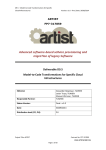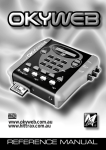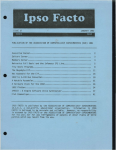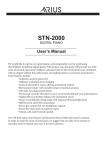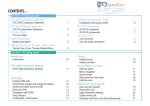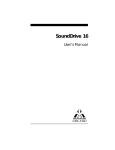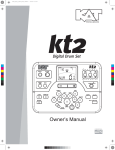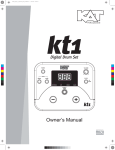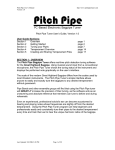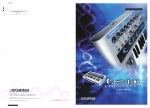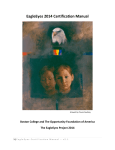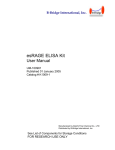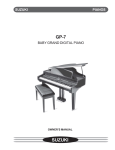Download User Manual
Transcript
User Manual Document version 1.01 23/03/2011 The vPipes Project, S.C. Contents 1. About this Manual ......................................................................................................................... 1 1.1. Software versions covered by this manual ....................................................................................... 1 1.2. Document version history ................................................................................................................. 1 2. Safeguards ..................................................................................................................................... 2 3. System Components ...................................................................................................................... 3 3.1. Box content ....................................................................................................................................... 3 3.2. Choosing an external audio amplifier ............................................................................................... 3 3.3. Connecting the system ...................................................................................................................... 3 3.4. Diagram ............................................................................................................................................. 5 4. Battery........................................................................................................................................... 6 4.1. Battery indicators .............................................................................................................................. 6 4.2. Charging Time and Duration ............................................................................................................. 6 4.3. Tips to saving battery power ............................................................................................................. 6 4.4. Increasing the life of your Li-Ion battery ........................................................................................... 6 5. Navigation ..................................................................................................................................... 7 5.1. Basic navigation concepts ................................................................................................................. 7 5.2. Play Mode vs. Setup Mode................................................................................................................ 7 Entering PLAY MODE from SETUP MODE ............................................................................................ 7 Entering SETUP MODE from PLAY MODE ............................................................................................ 7 5.3. Use of Play Mode Quick Menu .......................................................................................................... 7 6. Tone-Hole Sensors Calibration ....................................................................................................... 9 6.1. When should I calibrate? .................................................................................................................. 9 6.2. How to calibrate ................................................................................................................................ 9 6.3. Tightness and Proximity adjustments ............................................................................................... 9 Tightness .............................................................................................................................................. 9 Proximity ............................................................................................................................................ 10 6.4. Popping strap? ................................................................................................................................ 10 6.5. Monitoring the sensor response on the LDC screen ....................................................................... 10 7. Pressure Adjustment of the Bag Simulator .................................................................................. 11 7.1. Setting the low end pressure .......................................................................................................... 11 7.2. Setting the upper end pressure ...................................................................................................... 11 7.3. Playing without the bag simulator .................................................................................................. 12 i 8. vPipes – Uilleann Basic Tips ......................................................................................................... 13 8.1. Placement of the bag simulator ...................................................................................................... 13 8.2. Octave change ................................................................................................................................. 13 8.3. Information on how to finger a vibrato .......................................................................................... 14 8.4. Sharp or flats ................................................................................................................................... 14 8.5. Switching the drones on and off ..................................................................................................... 14 9. Metronome ................................................................................................................................. 15 9.1. Switching the metronome on and off ............................................................................................. 15 9.2. Metronome relative volume adjustment ........................................................................................ 15 9.3. How to choose the time signature .................................................................................................. 15 9.4. Metronome tempo ......................................................................................................................... 15 10. Other Adjustments ...................................................................................................................... 16 10.1. Adjusting the LCD light time ......................................................................................................... 16 10.2. Reseting the vPipes to factory settings ........................................................................................ 16 11. Sound Settings ............................................................................................................................. 17 11.1. Presets .......................................................................................................................................... 17 Sound Settings vs. Rest of Settings .................................................................................................... 17 Loading a preset ................................................................................................................................ 17 Preset Titles ....................................................................................................................................... 17 Loading a preset ................................................................................................................................ 18 Factory Presets .................................................................................................................................. 18 11.2. Master Volume ............................................................................................................................. 18 11.3. Transpose ..................................................................................................................................... 19 11.4. Sound Number ............................................................................................................................. 19 11.5. Temperament ............................................................................................................................... 20 11.6. Fine Tuning ................................................................................................................................... 20 11.7. Piping Mode ................................................................................................................................. 20 Uilleann Emu. ..................................................................................................................................... 20 General Midi ...................................................................................................................................... 20 General Midi Out ............................................................................................................................... 21 11.8. Emu Options ................................................................................................................................. 21 Drones Config .................................................................................................................................... 21 Drone 1 Key ................................................................................................................................... 21 Drone 2 Key ................................................................................................................................... 21 Drone 3 Key ................................................................................................................................... 21 Drone 1 Volume ............................................................................................................................ 21 Drone 1 Volume ............................................................................................................................ 21 Drone 1 Volume ............................................................................................................................ 22 Drift ............................................................................................................................................... 22 ii 11.9. GM Options .................................................................................................................................. 22 Base Note ........................................................................................................................................... 22 Sound Bank ........................................................................................................................................ 22 Drones Note # .................................................................................................................................... 23 Drones Volume .................................................................................................................................. 23 Popping Volume ................................................................................................................................ 23 11.10. Effects ........................................................................................................................................ 23 Reverb ................................................................................................................................................ 23 Level .............................................................................................................................................. 23 Type ............................................................................................................................................... 24 Chorus ................................................................................................................................................ 24 Level .............................................................................................................................................. 24 Type ............................................................................................................................................... 24 Spatial ................................................................................................................................................ 24 Master Level .................................................................................................................................. 24 Delay .............................................................................................................................................. 24 11.11. Equalizer .................................................................................................................................... 25 On / Off .............................................................................................................................................. 25 Low Band (Bass) ................................................................................................................................. 25 Med-Low Band ................................................................................................................................... 25 Med-High Band .................................................................................................................................. 25 High (Treble) ...................................................................................................................................... 25 11.12. Stereo Settings........................................................................................................................... 25 Mono / Stereo ................................................................................................................................... 26 Chanter Pan ....................................................................................................................................... 26 Drones Pan ......................................................................................................................................... 26 Metronome Pan ................................................................................................................................. 26 12. Troubleshooting .......................................................................................................................... 27 The instrument does not turn on ...................................................................................................... 27 Some sensors appear to be closed or partially closed on the screen even though no fingers are covering them .................................................................................................................................... 27 I can not close holes .......................................................................................................................... 27 No sound is heard .............................................................................................................................. 27 I can hear a lot of noise when I connect the vPipes-Uilleann to an external amplifier ..................... 27 13. Service information ..................................................................................................................... 28 APPENDIX A Fingering Chart ........................................................................................................... 29 APPENDIX B Menu map .................................................................................................................. 30 APPENDIX C List of instruments in the preloaded GM and MT-32 sound banks .............................. 32 APPENDIX D Midi Note Numbers .................................................................................................... 36 APPENDIX E Factory Sound Presets ................................................................................................ 37 1. D fx ............................................................................................................................................ 37 iii 2. 3. 4. 5. 6. 7. 8. iv C fx ............................................................................................................................................ 37 A fx ............................................................................................................................................ 37 D plain ....................................................................................................................................... 37 C plain ....................................................................................................................................... 37 Live 2 ch. ................................................................................................................................... 37 GM accord ................................................................................................................................. 37 GM harpsi.................................................................................................................................. 37 1. About this Manual This manual is intended for owners of the vPipes-Uilleann. To fully understand all the chapters in this manual, it is important that the reader understands how Uilleann pipes work and at least understands the basic characteristics and ornamentation of the traditional acoustic instrument. This manual is not, in any case, a tutorial for learning to play the Uilleann Pipes. You can download the latest version of this manual at: http://www.vpipes.com/downloads/vpipes_uilleann_user_manual_en.pdf There is also a Quick Start Guide with instructions to allow you to Plug&Play right from the box. The Quick Start Guide is included in the original package and can also be downloaded at: http://www.vpipes.com/downloads/vpipes_uilleann_quick_start_guide_en.pdf 1.1. Software versions covered by this manual vPipes – Uilleann software versions 01.XX 1.2. Document version history 1.01 23/03/2011 Correction in section 11.4. 1.00 20/03/2011 Initial version. vPipes-Uilleann User Manual Page 1 2. Safeguards Although the vPipes-Uilleann is robust please treat with care and observe the following guidelines to avoid damage: a) b) c) d) e) f) g) h) i) j) Handle this precision instrument with care Do not attempt to open any of the casings and voiding the guarantee Keep dry and avoid excessive moisture at all times Do not expose to extremes of temperature, dust or humidity Do not expose the Li-Ion battery to direct sunlight Do not drop or knock or submit the vPipes to heavy vibrations Do not use any cleaning/abrasive products or solvents Do not twist, pull or strain the cable Keep away from strong magnetic or electrical fields Only to be used for its intended purpose Page 2 vPipes-Uilleann User Manual 3. System Components 3.1. Box content The box in which the vPipes-Uilleann is sent contains 4 elements: a) b) c) d) Main unit (large rectangular box with the connection panel underneath) Chanter Unit Power adaptor (personalised according to country being sent to) Quick Start Guide Ensure that these four elements are in the box when it is received. 3.2. Choosing an external audio amplifier The vPipes-Uilleann does not contain any sound amplification system and you will need one to be able to listen to the vPipes. You can use any external amplifier connecting it to the AUDIO OUT jack of the main unit. You can use straightforward earbuds, headphones or the equipment used in a concert scenario by a 'supergroup'. The signal is provided by the 6.35mm jack and 3.5mm mini-jack. Both jacks can be used simultaneously. The vPipes default audio signal is stereo. This is useful when wanting to balance the chanter and drone sound, or to use independent channels for either one or send to a mixing table separately. Some of the sound effects included, such as Reverb and Spatial, make use of the stereo capability of the instrument. ! If you wish to connect a MONO amplifier, such as a guitar or similar amplifier, you will need to activate the left/mono mode under Settings, to avoid having distortion noise on the signal (see chapter 11.12). 3.3. Connecting the system To put the vPipes together you need only connect the round female connector at the end of the cable of the main unit to the round male connector on the rear of the chanter unit. The connector has only 1 position for insertion. Carefully align the notch before inserting. Please ensure that the chanter cable is not twisted or put under undue strain when playing. ! The screw-ring of the female connector on the main unit cable should tighten smoothly onto the male chanter connector. If the tightening is not smooth, disconnect and reconnect the sockets ensuring a tight and snug fit. The connectors only require approximately 3 whole turns without applying too much force to be correctly connected. The vPipes-Uilleann battery is pre-charged. If you wish to charge it further it can be connected to the mains (DC IN socket) found on the main unit. vPipes-Uilleann User Manual Page 3 Connect the external amplifying system of your choice and depress the ON/OFF button to the very bottom. It may be necessary to use the little finger to do so. If correctly depressed, a blue coloured light-ring should light up around the ON/OFF button and the LCD screen on the chanter unit will light up showing the model and software version. Read the rest of this manual to understand the basics of beginning to play and the different configuration options available. Page 4 vPipes-Uilleann User Manual 3.4. Diagram This diagram shows a complete image of both the main unit and the chanter unit with all the components: vPipes-Uilleann User Manual Page 5 4. Battery The vPipes includes a Li-Ion battery and internal charger. To charge the battery, connect the supplied mains charger to the main unit (DC IN). 4.1. Battery indicators When the main unit is running on battery power, the LCD screen on the chanter unit will show the percentage of battery (top right hand corner) whilst in the main menu (SETUP MODE). If connected to the mains charger, the word EXT will appear instead of a percentage number. ! Whilst plugged in to the mains, the red and green LED lights on the main unit show the battery charging status: Red = charging; green = charging complete 4.2. Charging Time and Duration The charging time of the battery, when completely discharged, is approximately 5 hours. The duration of the battery charge will depend on the adjustments chosen when configuring the vPipes, the length of time spent playing (Play Mode), the time spend carrying out adjustment (Setup Mode) and the age and use of the battery. In general, the battery can last between 6 and 12 hours. 4.3. Tips to saving battery power To make the battery last longer: reduce the LCD LIGHT TIME (see chapter 10.1) to a minimum, even switching off the light permanently (only if you know the menus very well of have very very good eyesight!) Another way to reduce battery power usage is to deactivate the on-screen sensor visualisation (see chapter 6.5). Using this option, the screen will remain off during PLAY MODE. We recommend that this option is not deactivated until you feel comfortable with the instrument and fully understand that calibration adjustments (see chapter 6). It is also important to switch off the vPipes when not in use. 4.4. Increasing the life of your Li-Ion battery Although vPipes has a charge controller it is recommended not to let Li-Ion batteries do too many deep discharges. NOTE: You can charge the battery and play at the same time. Page 6 vPipes-Uilleann User Manual 5. Navigation 5.1. Basic navigation concepts As can be seen in the diagram in chapter 3.4, there is a small touch-pad on the rear of the chanter unit that allows for navigation in all the menus in SETUP MODE, and also allows for the activation/deactivation of the drones during PLAY MODE or altering notes (sharps or flats) while playing. The menu has been designed as a multi-level tree structure such that to navigate 'vertically' you need to press the () to get to the different options within a particular menu level, then pressing () to enter the selected option or () to go up a level within the menu. Once you have reached a particular setting whose value you wish to change, for example, Sound Settings > Transpose, you will be able to vary the values using the to increase its value or to decrease it. Once the value has been changed, press to accept the change or to cancel it. To indicate the route for accessing the different menu options, we shall always take the initial screen that appears when you first switch on the vPipes and shall call this the Home Screen: SETUP MODE Sound Settings Fig. 1 Home Screen 5.2. Play Mode vs. Setup Mode The vPipes has two working modes: Play Mode and Setup Mode. In PLAY MODE, the vPipes will start to sound the moment pressure is applied to the bag simulator (main unit) and you will only have access to certain basic parameters when no pressure is applied (see chapter 5.3). In SETUP MODE you will have access to all the configuration options. Upon switching the vPipes on, the initial HOME SCREEN will appear automatically and it will show SETUP MODE. Entering PLAY MODE from SETUP MODE Simply press once you have reached the top level in SETUP MODE. Entering SETUP MODE from PLAY MODE Press and simultaneously. 5.3. Use of Play Mode Quick Menu In order to easily access some basic parameters in PLAY MODE, when no pressure is applied to the bag simulator the quick menu screen will appear. The navigation in this Quick Menu is different to that used in SETUP MODE. To change from one option to another press (left) vPipes-Uilleann User Manual Page 7 or (right). To vary the value of each of the options use the up and down arrow keys ( or ) and there is no need to press to confirm the change. The adjustable parameters on the quick menu are as follows: Preset > Volume > Transpose > Metronome Tempo (only if the metronome is activated) ! If a change is made in the Preset option, the volume and transpose values stored in the selected preset will override the volume and transpose values of the quick menu. Once a preset has been loaded and tested, the values of Volume and Transpose can be modified subsequently in the quick menu. Page 8 vPipes-Uilleann User Manual 6. Tone-Hole Sensors Calibration A substantial part of the ‘magic’ of the vPipes-Uilleann resides in the optimum working condition and calibration of the tone-hole sensors. Please follow these instructions to achieve the best response from the tone-hole sensors. 6.1. When should I calibrate? It is not necessary to calibrate the vPipes each time you play. It is recommended to recalibrate if you haven’t used the vPipes for a while or when you change location. Overall, if you feel that any one of the sensors is behaving erratically, then recalibrate. ! When viewing tone-hole sensors on the screen (see chapter 6.5), you can tell if the sensors are responding incorrectly if when lifting a finger the image doesn't show a U shape or, conversely, when fully placing a finger on a tone-hole sensor the image should be a filled in O. 6.2. How to calibrate Follow this sequence from the Home Screen position: : Sensitivity : Calibration : Confirm You have 3 seconds to hold the chanter by the head and hold it away from any nearby objects (including yourself). Don't forget that there is also a sensor on the end of the chanter, the bottom hole sensor. 6.3. Tightness and Proximity adjustments By using the Tightness and Proximity adjustments, you can modify the degree of sensitivity of the sensors. Tightness The Tightness parameter determines how easy or difficult it is to completely cover the holes. A high Tightness value will mean that the tone-hole sensors are more difficult to cover properly requiring very precise fingering. A low Tightness value means that the tone-hole sensors will be easier to cover properly. The downside is that the slides will have a shorter run and the vibratos will be less smooth. We advise to set the Tightness parameter as high as is comfortable for you. vPipes-Uilleann User Manual Page 9 The default value for this parameter is 15 and you can change it by following this sequence from the Home Screen: x4 Proximity The Proximity parameter allows you to set the degree of sensitivity of the sensors to the proximity of your fingers. A high Proximity value will mean that the sensors will not detect your fingers until they are in contact with them. A low Proximity value will mean that the sensors will detect your fingers before actually touch them. The default value is 1. To obtain good slides and vibratos we recommend that you keep the default value. If after calibrating you see that a sensor doesn’t open all the way when you lift a finger completely off, increase this values to 2 or 3. You can get to the Proximity parameter by following this sequence from the Home Screen: x5 6.4. Popping strap? It is not normally necessary but if you do have a problem in completely closing off the bottom sensor on your leg (i.e. when wearing thick corduroy or ski-ing trousers…!) you can use any metallic object to rest the chanter on instead of directly on your clothes. A piece of silver biscuit wrapper or silver foil works quite well. 6.5. Monitoring the sensor response on the LDC screen The vPipes allows you to monitor the reaction of the sensors on the LCD screen, in graphic form, when you place your fingers on them. This characteristic is activated by default. If you prefer to deactivate this characteristic please follow the sequence below starting from the Home Screen: x3 Page 10 vPipes-Uilleann User Manual 7. Pressure Adjustment of the Bag Simulator Use the following sequence from the Home Screen to arrive at the pressure adjustment option: When you now press the bag simulator you will see >>>> symbols appearing, which indicate the level of force being applied. What you see on the screen represents the level of force applied according to the current pressure adjustment setting. The force required for the first > symbol to appear represents the pressure required for the vPipes to start sounding in Play Mode. The arrow symbols vary in number according to the pressure applied, from one > ( the minimum force required for any sound ) to 16 > ( the maximum requirement for maintaining the highest notes. Please follow the following instruction to learn how to change these levels. 7.1. Setting the low end pressure To set the level at which you want the vPipes to start sounding, apply just enough pressure so that you don’t drop the bag and press . Ignore the >>>> symbols displayed in the screen. You should now see the following message on the screen which will last for 1 second: << OK. If the following message appears: >>> ERROR <<<, it means that the pressure applied is greater than that required at the upper end. Try setting the low end pressure again. Now the >>>>> symbols show the level of pressure applied taking into account the new adjustment. 7.2. Setting the upper end pressure To set the pressure necessary to maintain the top notes in the second octave, apply the amount of pressure that you find comfortable or that resembles the pressure required on your acoustic set to maintain the high B in the second octave and press ( again, ignore the >>>>>> symbols that appear on the screen before pressing ). You should now see the following message on the screen which will last for 1 second: OK >>. If the following message appears: >>> ERROR <<<, it means that the pressure applied is less than that required at the low end. Try setting the high end pressure again. Now the >>>>> symbols show the level of pressure applied taking into account the new adjustment. vPipes-Uilleann User Manual Page 11 When you are happy with the new adjustments press to confirm the changes. You can also cancel the changes made by pressing at any time. ! Using a low pressure adjustment for the upper end may cause the vPipes to respond incorrectly during Play Mode. 7.3. Playing without the bag simulator This is a very curious characteristic of the vPipes-Uilleann. You can play without using the bag simulator and you will be surprised at the fact that with a bit of practice you can play many melodies and change octave without a problem. For some melodies the octave change will prove to be difficult as will achieve a good cranning. The 'no-pressure' mode is especially useful for those with disabilities that don't allow for applying the necessary pressure on the bag simulator. To reach this mode use the following sequence from the Home Screen: x2 Page 12 vPipes-Uilleann User Manual 8. vPipes – Uilleann Basic Tips Although the vPipes-Uilleann is a faithful Uilleann pipes emulator, you will notice quite a big difference when compared to your acoustic set, but that also happens when you play with a borrowed acoustic set and one that you are not used to. Please be patient and give yourself some time to get used to this new instrument. 8.1. Placement of the bag simulator Although many pipers are used to placing the bag of their pipes very tightly against the armpit, do not adopt the same position with the vPipes. The vPipes bag simulator is designed so that the oval shaped block is actioned by the forearm: Fig. 2 Correct placement of the bag simulator 8.2. Octave change The emulation of the octave change on the vPipes-Uilleann is one of the most praised characteristics by pipers around the world. The octave change is very, very similar to that on an acoustic set, notwithstanding please read the following tips which will help you: - If you have a problem reaching the high octave, please check that the sensors are correctly calibrated. Be especially vigilant that the bottom sensor, is fully closed when resting on your leg (see chapter 6). Do not try and go up to the second octave by applying more pressure on the simulated bag. It is not necessary to apply more pressure than the upper end pressure level as defined in the pressure adjustment (see chapter 7.2) - If you jump to the second octave by mistake repeatedly it is probable that you are applying too much pressure when playing or conversely that you have to increase the upper end pressure level (see chapter 7.2) vPipes-Uilleann User Manual Page 13 8.3. Information on how to finger a vibrato The manner in fingering a vibrato on the vPipes-Uilleann is also very similar to that of an acoustic set but there are some differences that are important to be aware of. The main difference is that on a traditional acoustic set there are many ways to execute a vibrato and cross finger on each note, all with subtle differences that depend on the pipe maker and indeed, the reed itself. In this first SW version of the vPipes-Uilleann we have chosen to implement a vibrato, that although very simplified, feels very natural when playing and offers very good results. To execute a vibrato on a specific note, starting from a closed position, just flutter one or various fingers of your right hand (or left hand for left-handed players) that are below the open hole on the chanter, in such a way that if you were to completely close the fingers that you are fluttering, the position obtained would be the closed position of the played note (see APPENDIX A for further information on open and closed positions for each note). Although the explanation seems quite complicated, the actual execution is very straightforward and feels very natural when playing. It is probable that you have already achieved the vibrato effect on your vPipes before reading this part of the manual. 8.4. Sharp or flats It is as if you had a fully keyed chanter! Simply use the & whilst playing to execute the sharp of flat of the note that is currently being played. 8.5. Switching the drones on and off To activate the drones press whilst playing (Play Mode and applying pressure to the bag simulator). To switch the drones off press whilst playing. The drone setting remains when you release the pressure on the bag simulator to access the quick menu and when you resume playing. Page 14 vPipes-Uilleann User Manual 9. Metronome The vPipes-Uilleann includes a complete metronome that you can activate to help strengthen your sense of rhythm. 9.1. Switching the metronome on and off Use the following sequence from the Home Screen to reach the metronome options: x2 x2 9.2. Metronome relative volume adjustment Sequence: x2 You can adjust the metronome’s volume from 0 to 15. The volume will be relative to the Master Volume level. 9.3. How to choose the time signature It is very straightforward. Let’s see some examples: - If you want to practice with a reel or hornpipe rhythm (4/4 time), select 4 on the Meter Top parameter and 4 on the Meter Bottom parameter. - If you want to practice with a jig rhythm (6/8 time), select 6 on the Meter Top parameter and 8 on the Meter Bottom parameter. - If you want to practice with a Bulgarian rhythm (7/8 time), select 7 on the Meter Top parameter and 8 on the Meter Bottom parameter. Sequence for Meter Top: x2 x2 Sequence for Meter Bottom: x2 x3 9.4. Metronome tempo Sequence: x2 x4 You can adjust this parameter from 0 to 20, 0 being the slowest tempo and 20 being the fastest tempo. One way of doubling the tempo speed is to double the Meter Bottom value. For example, using 8 instead of 4 when playing a reel. Conversely, if you want to halve the tempo, divide the Meter Bottom by two. vPipes-Uilleann User Manual Page 15 10. Other Adjustments 10.1. Adjusting the LCD light time Sequence: x3 x2 With the aim of reducing the battery consumption, you can choose the length of time that you wish the screen to light up. When the external charger is connected the LCD screen is lit all the time. 10.2. Reseting the vPipes to factory settings Sequence: x4 This option will return all the configuration values to default. This will not affect the presets in any way. ! The factory presets cannot be recovered once modified or deleted. The calibration data will be lost after this type of reset so you must remember to recalibrate the vPipes after factory default reset. Page 16 vPipes-Uilleann User Manual 11. Sound Settings In this chapter you will learn all about the configuration parameters that make the vPipes sound one way or another (volume, transpose, reverb, etc.) You will also learn how to save these parameters into a preset so that you can have them readily to hand and use them whenever you wish. The remainder of the chapter analyses each of the categories and parameters following the same order as that which appears on the screen. 11.1. Presets A preset is a space in the vPipes memory reserved to store a specific combination of parameter adjustments so that they can be easily reloaded at any time. You can store up to 10 presets on the vPipes. Added to these 10 presets, you also have the Default preset at number 0 that cannot be modified or deleted. Each time you turn your vPipes on, the last preset that was used will be loaded. Sound Settings vs. Rest of Settings Sound Setting refers to all those parameters that are related to the sound the vPipes makes. These are all the parameters that appear in the menu under the category of Sound Settings and are the only ones that will be saved when stored in a preset. Loading a preset To load a preset follow the sequence from the Home Screen: x3 Then use the & buttons until you reach the preset that you want to load and press to accept. An alternative way of loading a preset is to use the & buttons when in the Quick Menu in Play Mode (see chapter 5.3). Preset Titles Before saving a preset make sure you name it so it will be easily identifiable for you when you want to use it again. Use the following sequence from the Home Screen to get to the preset title editor: x2 You will see the name of the last preset loaded or saved. If the last preset used was the Default then the title screen will be blank. You can use up to 10 characters to name a preset. Use the & buttons to move the blinking cursor left or right according to the character that you want to change. vPipes-Uilleann User Manual Page 17 By pressing when the cursor is at the first position, the operation will be cancelled and you will be taken back to the previous screen without any changes being saved. By pressing when the cursor is on the last position (to the far right of the screen), this will confirm the operation and the next time you save a preset it will be saved with the title you have just written. If you want to keep the same title as the previous preset loaded or saved, there is no need to go to the title editor as the title will be kept the same. Loading a preset Once you are happy with the selected Sound Settings and with the title that you have chosen, follow the sequence from the Home Screen to save these settings in one of the 10 available slots: x2 x2 Now use the & buttons until you find the slot in which you want to save the preset and press to accept. Factory Presets The vPipes-Uilleann comes preloaded with 8 factory preset configurations. Although once modified or substituted these presets can not be recovered (see chapter 10.2), DO NOT WORRY, they are only examples of what can be done and the possibilities offered by the vPipes-Uilleann. You will be able to create the same presets and other more interesting ones by following the instructions in this manual. Here is a description of the factory setting presets: 0) 1) 2) 3) 4) 5) 6) Default: Preset in C with a very light reverb (not modifiable). D fx: Set in D with a medium level reverb (Alain Froment D chanter samples). C fx: Set in C with a medium level reverb (Leo Rowsome C changer samples). A fx: Set in A with reverb (C fx transposed -3 semitones). D plain: Set in D with no sound effects. C plain: Set in C with no sound effects. Live 2 ch.: With no effects, chanter through left channel and drones through right channel. Ideal to send to a mixing table when playing live (see chapter 11.12) 7) GM accord.: General MIDI mode with accordion sounds. 8) GM harpsi.: General MIDI mode with harpsichord sound. 11.2. Master Volume Sequence Range Default value 0 to 15 5 Use the & to adjust the general volume of the instrument and press to accept or to cancel. This step will be taken for granted in the following adjustments. Page 18 vPipes-Uilleann User Manual It is sometimes quite uncomfortable for the general volume to be associated to the Sound Settings because every time you change the preset, the volume changes according to the preset volume level. Imagine that you are playing in bed with headphones, the volume of which you have adjusted to 1 but you load a preset from the quick menu which has a volume of 12… ! Remember to check the volume each time you change a preset to avoid harming your hearing. Both things can be done from the quick menu under Play Mode. The advantage of having the general volume associated to Sound Settings is that you can adjust the volume of each preset individually when wishing to compensate the increase in volume caused by the reverb and chorus effects, or that you simply want a particular preset to have a specific volume when playing live. 11.3. Transpose Sequence Range Default value x2 -12 to 12 (semitones) 0 With this parameter you can transpose the tuning of the instrument 1 octave below to 1 octave above (tinkerbell pipes!) Please note that this transposition is relative to the original key in which the sound samples were made. If you are using the samples of the D pipes and you transpose -3 semitones, you will be playing in the key of B. The same transposition of -3 when playing the pipes in C will change the key to A. Please see chapter 11.4 to learn more about the tuning of the original sound samples. 11.4. Sound Number Sequence Range Default value x3 0 to 127 1 Use this parameter to select the sound of your vPipes. In emulation mode (see chapter 11.7) only 2 sounds are available: 0: Uilleann pipes in D 1: Uilleann pipes in C ! Any other value other than 0 or 1 in the Sound Number when in emulation mode will mean that the vPipes-Uilleann will make no sound. vPipes-Uilleann User Manual Page 19 11.5. Temperament Sequence Range Default value x4 Just intonation Equal temp. Just intonation This parameter allows for the selection of either equal temperament or just intonation (also called Drone Tuning). The variation in tuning for “just intonation” and “equal temperament” are taken from the book “The Uilleann Pipe Reedmaker’s Guidance Manual” by Dave Hegarty, published by Na Píobairí Uilleann. This guide is freely available at the following link: http://www.pipers.ie/Documents/Reedmakers_Guide.pdf 11.6. Fine Tuning Sequence Range Default value x5 -100 to 100 (semitone cents) 0 By means of this parameter you can adjust the general tuning of the vPipes in cents, allowing you to fine tune with another instrument. 11.7. Piping Mode Sequence Range Default value x6 Uilleann Emu. General Midi General Midi Out Uilleann Emu. The Piping Mode parameter allows you to choose the mode of your vPipes. The following is a description of each of the available modes: Uilleann Emu. This is Uilleann pipes emulation mode. This is the most important mode and is the element that differentiates the vPipes-Uilleann from all other electronic instruments. By using this mode, the vPipes-Uilleann faithfully emulates the workings and sound of a Uilleann half-set. This mode uses a synthesis model developed exclusively for the vPipes-Uilleann. It is based on the use of the sensors that recognise partially covered holes thus affording the possibility of fingering vibratos and slides as if playing a traditional acoustic set. In section 11.8 you can see a list of settings that only affect this mode in the vPipesUilleann. General Midi The General Midi mode allows for the selection of one of the 256 preloaded sounds. Please see chapter 11.4 and 11.9 (Sound Bank) to learn how to access these sounds. Page 20 vPipes-Uilleann User Manual Under this mode the sensors on the vPipes are considered either completely open or completely closed and therefore exclude the fingering of vibratos, slides or popping. However, fingering the notes and changing octave work exactly as in the emulation mode. General Midi Out This mode is the same as the previous one with the exception that the MIDI messages are sent to the MIDI OUT port, thus allowing you to connect the instrument to the MIDI IN port of an external synthesiser or a computer. Under section 11.9 you will find a list of settings that only affect the modes under General MIDI. 11.8. Emu Options Drones Config This category is exclusive to the Emulation Mode, and allows you to transpose and change the volume of the drones independently of each other which affords the possibility of creating any chord. Drone 1 Key Sequence Range Default value x7 x3 -12 to 12 (semitones) 0 Transposing for the Base drone Drone 2 Key Sequence Range Default value x7 x2 -12 to 12 (semitones) 0 Transposing for the Baritone drone Drone 3 Key Sequence Range Default value x7 x2 x2 -12 to 12 (semitones) 0 Transposing for the Tenor drone Drone 1 Volume Sequence Range Default value x7 x2 x3 0 to 15 8 Relative volume of the Base drone Drone 1 Volume Sequence Range Default value vPipes-Uilleann User Manual x7 x2 x4 0 to 15 8 Page 21 Relative volume of the Baritone drone Drone 1 Volume Sequence Range Default value x7 x2 x5 0 to 15 8 Relative volume of the Tenor drone Drift Sequence Range Default value x7 x2 x6 0 to 10 2 The Drift parameter allows for the adjustment of the sensitivity of the drones to the bag-pressure applied. With high values of Drift the drones will be prone to going out of tune more easily. With a Drift setting of 0 the drones will always be perfectly in tune. With a Drift value of 2 (default), the sound produced is very realistic as it allows for slight, almost imperceptible, variations in the tuning of the drones. 11.9. GM Options The adjustments under this category only affect the vPipes when playing in General MIDI mode. They have no effect when playing in Emulation mode. Please see chapter 11.7 to learn more about the different modes available. Base Note Sequence Range Default value x8 x2 0 to 103 38 Imagine a grand piano with 128 white and black keys numbered from left to right from 0 to 127. This is a range of almost 11 octaves in which any of the preloaded midi sounds can play in. It is a very big range compared to the two octaves that can be played on the Uilleann chanter. The ‘Base-Note’ parameter allows you to choose which of the piano keys you want to correspond to the lowest note of the Uilleann chanter, i.e. bottom D. The default value corresponds to a D of the second octave. Sound Bank Sequence Range Default value x8 0 to 126 0 The vPipes-Uilleann has two preinstalled sound banks. This parameter allows you to choose either of the two (0 or 1) to play in General MIDI. Page 22 vPipes-Uilleann User Manual Each of these sound banks has 128 sampled instruments. Please see APPENDIX C to learn more about the available instruments in each sound bank. ! Any value different to 0 or 1 in the Sound Bank parameter in General MIDI mode will make no sound. Drones Note # Sequence Range Default value x8 x2 0 to 127 26 This is the note on our virtual keyboard with 128 keys that we want to sound like the drone when is pressed whilst we play in General MIDI (please see chapter 8.5 to learn how to activate and deactivate the drones). Drones Volume Sequence Range Default value x8 x3 0 to 15 8 This is the relative volume of the drones whilst playing in General MIDI mode. Popping Volume Sequence Range Default value x8 x4 -15 to 15 0 This parameter allows for the notes to sound with a different volume when the chanter is lifted off the knee. Popping volume = 0 means that there is no change in volume when lifting the chanter off the knee. 11.10. Effects Reverb Level Sequence Range Default value x9 x3 0 to 15 5 Reverb level. vPipes-Uilleann User Manual Page 23 Type Sequence Range Default value x9 x2 Room 1 Room 2 Room 3 Hall 1 Hall 2 Plate Delay Pan Delay Hall 2 Reverb type. Chorus Level Sequence Range Default value x9 x2 0 to 15 0 Chorus level. Type Sequence Range Default value x9 Chorus 1 Chorus 2 Chorus 3 Chorus 4 Feedback Flanger Short Delay FB Delay Chorus 3 Chorus type. Spatial Master Level Sequence Range Default value x9 x2 x2 0 to 15 0 Spatial effect level. Delay Sequence Range Default value x9 x2 0 to 15 0 Amount of delay in the spatial effect. Page 24 vPipes-Uilleann User Manual 11.11. Equalizer The vPipes includes a four-band parametric equalizer. Modify the following parameters to your liking. On / Off Sequence Range Default value x10 x2 On Off Off On to activate the equalizer and Off to deactivate it. Low Band (Bass) Sequence Range Default value x10 -12 to 12 dB 0 Equalizer low band level. Med-Low Band Sequence Range Default value x10 x2 -12 to 12 dB 0 Equalizer medium-low band level. Med-High Band Sequence Range Default value x10 x3 -12 to 12 dB 0 Equalizer mid-high band level. High (Treble) Sequence Range Default value x10 x4 -12 to 12 dB 0 Equalizer high band level. 11.12. Stereo Settings The vPipes default audio signal is stereo. This offers many advantages such as improving the reverb, chorus and spatial effects, balancing the chanter and drone sound, and even completely separating the chanter and drone sounds through two different channels for separate treatment by mixing desks. vPipes-Uilleann User Manual Page 25 Mono / Stereo Sequence Range Default value x11 x2 Stereo Left-Mono Stereo Use the Left-Mono option if you are going to connect a mono jack to the vPipes OTHERWISE there will be noise at the output signal. Chanter Pan Sequence Range Default value x11 -10 to 10 0 Pans the chanter sound. A setting at -10 will only produce chanter sound through the left channel. A value of 10 will do the same but through the right channel. 0 produces a completely balanced sound through right and left channels. Drones Pan Sequence Range Default value x11 x2 -10 to 10 0 Drone pan. A setting at -10 will only produce drone sound through the left channel. A value of 10 will do the same but through the right channel. 0 produces a completely balanced sound through right and left channels. Metronome Pan Sequence Range Default value x11 x3 -10 to 10 0 Metronome pan. A setting at -10 will only produce metronome sound through the left channel. A value of 10 will do the same but through the right channel. 0 produces a completely balanced sound through right and left channels. Page 26 vPipes-Uilleann User Manual 12. Troubleshooting The instrument does not turn on Ensure that the battery is charged or connect the unit to the external charger. Switch off and turn on the unit. Ensure a correct connection between the main unit and the chanter (see chapter 3.3) Some sensors appear to be closed or partially closed on the screen even though no fingers are covering them Calibrate the unit (see chapter 6). Ensure that the Proximity parameter is correct (see chapter 6.3). I can not close holes Calibrate the unit (see chapter 6). Ensure that the Tightness parameter is correct (see chapter 6.3). No sound is heard Ensure that the unit is connected to an external sound amplifier (see chapter 3.2) Calibrate the unit (see chapter 6). Ensure that the pressure adjustment is correct (see chapter 7). Use the Default preset to eliminate any possible error in the options chosen. Reset to factory settings and calibrate the unit. Ensure a correct connection between the main unit and the chanter (see chapter 3.3) I can hear a lot of noise when I connect the vPipes-Uilleann to an external amplifier If you are using a mono jack to connect the unit make sure you have selected Left-Mono mode in the settings (see chapter 11.12). Ensure that the jack has been fully plugged in. Ensure that the audio cable is in good condition. vPipes-Uilleann User Manual Page 27 13. Service information For any questions you may have regarding the vPipes or if you want to inform us of a problem or malfunctions please contact us at the following address: [email protected]. Page 28 vPipes-Uilleann User Manual APPENDIX A Fingering Chart Name of note No sound Bottom D Ghost D Ghost D off the knee E E off the knee F nat close F nat open F nat close off the knee F nat open off the knee G close G open G close off the knee G open off the knee A close A open A close off the knee A open off the knee B close B open B close off the knee B open off the knee C nat close C nat open C nat close off the knee C nat open off the knee C sharp close C sharp open C sharp close off the knee C sharp open off the knee Back D close Back D open Back D close off the knee Back D open off the knee Fingering Back D Bell Open hole Closed hole Indifferent (hole can be open or closed) vPipes-Uilleann User Manual Page 29 APPENDIX B Menu map PLAY MODE SETUP MODE Sound Settings Sound Presets Load Preset Title Save Master Volume Transpose Sound Number Temperament Fine Tuning Piping Mode Emu. Options Drones Config Drone 1 Key Drone 2 Key Drone 3 Key Drone 1 Volume Drone 2 Volume Drone 3 Volume Drift Gm Options Base Note Sound Bank Drones Note # Drones Volume Popping Volume Effects Reverb Level Type Chorus Level Type Spatial Master Level Delay Equalizer On / Off Low Band (Bass) Med-Low Band Med-High Band Page 30 vPipes-Uilleann User Manual High (Treble) Stereo Settings Mono / Stereo Chanter Pan Drones Pan Metronome Pan Sensitivity Calibration Bag Pressure Adj No Bag Mode View Holes Tightness Proximity Metronome On / Off Volume Meter Top Meter Bottom Tempo Lcd Options Light Time Reset Options vPipes-Uilleann User Manual Page 31 APPENDIX C List of instruments in the preloaded GM and MT-32 sound banks Sound Number 0 1 2 3 4 5 6 7 8 9 10 11 12 13 14 15 16 17 18 19 20 21 22 23 24 25 26 27 28 29 30 31 32 33 34 Page 32 Sound Bank 0 (General Midi) (Grand) Piano 1 (Bright) Piano 2 (El. Grd) Piano 3 Honky-tonk Piano El. Piano 1 El. Piano 2 Harpsichord Clavi Celesta Glockenspiel Music Box Vibraphone Marimba Xylophone Tubular Bells Dulcimer (Santur) Drawbar Organ Percussive Organ Rock Organ Church Organ Reed Organ Accordion (french) Harmonica Tango Accordion Ac. Guitar (Nylon) Ac. Guitar (Steel) El. Guitar (jazz) El. Guitar (clean) El. Guitar (muted) Overdriven Guitar Distortion Guitar Guitar harmonics Acoustic Bass Finger Bass Picked Bass Sound Bank 1 (MT-32) Acou Piano 1 Acou Piano 2 Acou Piano 3 Elec Piano 1 Elec Piano 2 Elec Piano 3 Elec Piano 4 Honky Tonk Elec Org 1 Elec Org 2 Elec Org 3 Elec Org 4 Pipe Org 1 Pipe Org 2 Pipe Org 3 Accordion Harpsi 1 Harpsi 2 Harpsi 3 Clavi 1 Clavi 2 Clavi 3 Celesta 1 Celesta 2 Syn Brass 1 Syn Brass 2 Syn Brass 3 Syn Brass 4 Syn Bass 1 Syn Bass 2 Syn Bass 3 Syn Bass 4 Fantasy Harmo Pan Chorale vPipes-Uilleann User Manual Sound Number 35 36 37 38 39 40 41 42 43 44 45 46 47 48 49 50 51 52 53 54 55 56 57 58 59 60 61 62 63 64 65 66 67 68 69 70 71 72 73 74 75 76 77 Sound Bank 0 (General Midi) Fretless Bass Slap Bass 1 Slap Bass 2 Synth Bass 1 Synth Bass 2 Violin Viola Cello Contrabass Tremolo Strings Pizzicato Strings Orchestral Harp Timpani String Ensemble 1 String Ensemble 2 Synth Strings 1 Synth Strings 2 Choir Aahs Voice Oohs Synth Voice Orchestra Hit Trumpet Trombone Tuba Muted Trumpet French Horn Brass Section Synth Brass 1 Synth Brass 2 Soprano Sax Alto Sax Tenor Sax Baritone Sax Oboe English Horn Bassoon Clarinet Piccolo Flute Recorder Pan Flute Blown Bottle Shakuhachi vPipes-Uilleann User Manual Sound Bank 1 (MT-32) Glasses SoundTrack Atmosphere Warm Bell Funny Vox Echo Bell Ice Rain Obeo 2001 Echo Pan Doctor Solo School Daze BellSinger Square Wave Str Sect 1 Str Sect 2 Str Sect 3 Pizzicato Violin 1 Violin 2 Cello 1 Cello 2 Contrabass Harp 1 Harp 2 Guitar 1 Guitar 2 Elec Gtr 1 Elec Gtr 2 Sita Acou Bass 1 Acou Bass 2 Elec Bass 1 Elec Bass 2 Slap Bass 1 Slap Bass 2 Fretless 1 Fretless 2 Flute 1 Flute 2 Piccolo 1 Piccolo 2 Recorder Pan Pipes Page 33 Sound Number 78 79 80 81 82 83 84 85 86 87 88 89 90 91 92 93 94 95 96 97 98 99 100 101 102 103 104 105 106 107 108 109 110 111 112 113 114 115 116 117 118 119 120 Page 34 Sound Bank 0 (General Midi) Whistle Ocarina Lead 1 (square) Lead 2 (sawtooth) Lead 3 (calliope) Lead 4 (chiff) Lead 5 (charang) Lead 6 (voice) Lead 7 (fifths) Lead8 (bass+lead) Pad 1 (new age) Pad 2 (warm) Pad 3 (polysynth) Pad 4 (choir) Pad 5 (bowed) Pad 6 (metallic) Pad 7 (halo) Pad 8 (sweep) FX 1 (rain) FX 2 (soundtrack) FX 3 (crystal) FX4 (atmosphere) FX 5 (brightness) FX 6 (goblins) FX 7 (echoes) FX 8 (sci-fi) Sitar Banjo Shamisen Koto Kalimba Bag pipe Fiddle Shanai Tinkle Bell Agogo Steel Drums Woodblock Taiko Drum Melodic Tom Synth Drum Reverse Cymbal Gt. Fret Noise Sound Bank 1 (MT-32) Sax 1 Sax 2 Sax 3 Sax 4 Clarinet 1 Clarinet 2 Oboe Engl Horn Bassoon Harmonica Trumpet 1 Trumpet 2 Trombone 1 Trombone 2 Fr Horn 1 Fr Horn 2 Tuba Brs Sect 1 Brs Sect 2 Vibe 1 Vibe 2 Syn Mallet Wind Bell Glock Tube Bell Xylophone Marimba Koto Sho Shakuhachi Whistle 1 Whistle 2 Bottleblow Breathpipe Timpani Melodic Drum Deep Snare Elec Perc 1 Elec Perc 2 Taiko Taiko rim Cymbal Castanets vPipes-Uilleann User Manual Sound Number 121 122 123 124 125 126 127 Sound Bank 0 (General Midi) Breath Noise Seashore Bird Tweet Teleph. Ring Helicopter Applause Gunshot vPipes-Uilleann User Manual Sound Bank 1 (MT-32) Triangle Orche Hit Telephone Bird Tweet One Note Jam Water Bell Jungle Tune Page 35 APPENDIX D Midi Note Numbers Note Numbers Octave C C# D D# E F F# G G# A A# B -1 0 1 2 3 4 5 6 7 8 9 10 11 0 12 13 14 15 16 17 18 19 20 21 22 23 1 24 25 26 27 28 29 30 31 32 33 34 35 2 36 37 38 39 40 41 42 43 44 45 46 47 3 48 49 50 51 52 53 54 55 56 57 58 59 4 60 61 62 63 64 65 66 67 68 69 70 71 5 72 73 74 75 76 77 78 79 80 81 82 83 6 84 85 86 87 88 89 90 91 92 93 94 95 7 96 97 98 99 100 101 102 103 104 105 106 107 8 108 109 110 111 112 113 114 115 116 117 118 119 9 120 121 122 123 124 125 126 127 Page 36 vPipes-Uilleann User Manual APPENDIX E Factory Sound Presets The factory presets (except Default) cannot be recovered once they have been modified or deleted. If you want to recover them please apply the adjustments that appear below starting from the Default preset: 1. D fx - Sound Number = 0 Reverb Level = 8 2. C fx - Reverb Level = 8 3. A fx - Reverb Level = 10 Transpose = -3 4. D plain - Sound Number = 0 Reverb Level = 0 5. C plain - Reverb Level = 0 6. Live 2 ch. - Sound Number = 0 Reverb Level = 0 Chanter Pan = 10 RIGHT Drones Pan = -10 LEFT 7. GM accord - Sound number = 15 Temperament = Equal temp. Piping mode = General Midi Sound Bank = 1 Popping Volume = 10 8. GM harpsi. - Sound number = 6 Temperament = Equal temp. Piping mode = General Midi Sound Bank = 0 Popping Volume = 10 vPipes-Uilleann User Manual Page 37 © 2011 The vPipes Project, S.C.














































